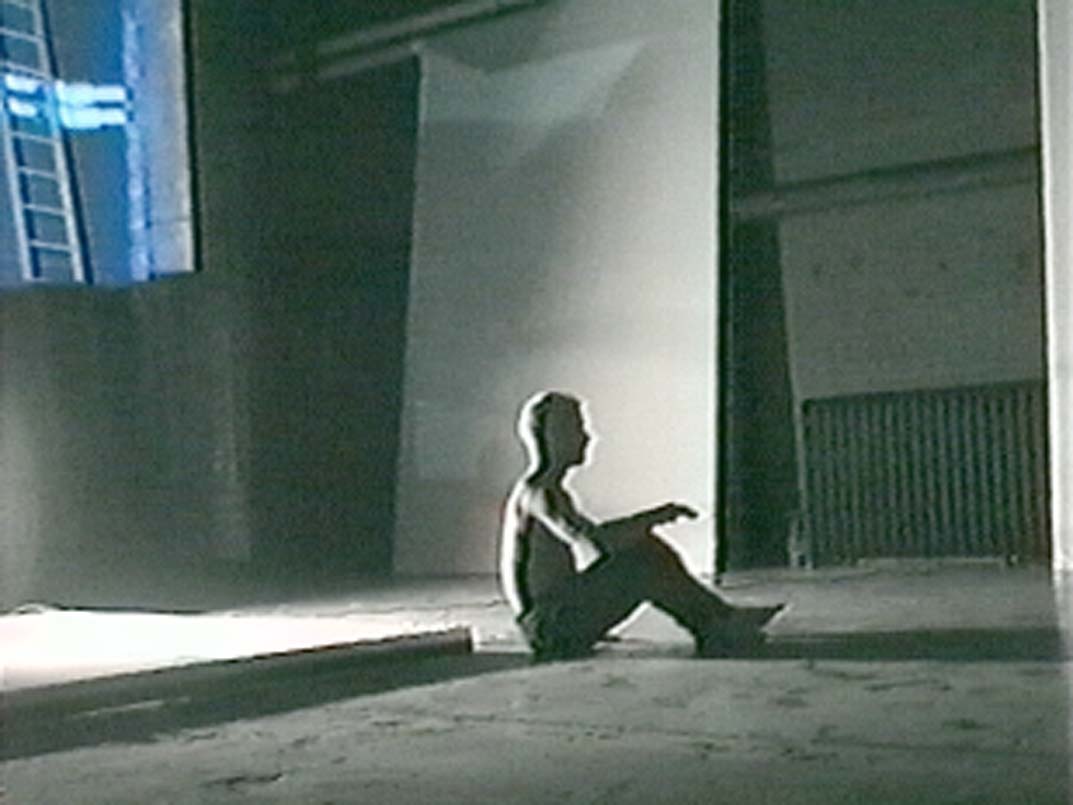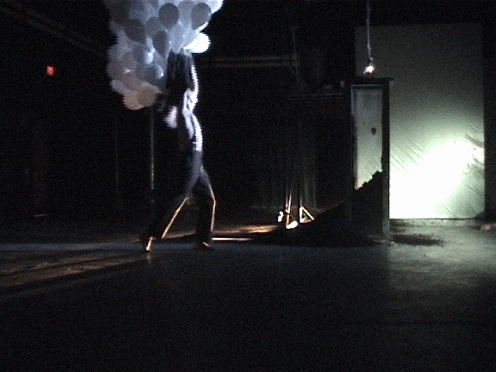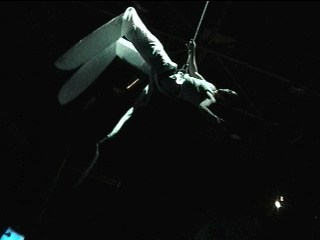Design And Performance Lab
|
burial.1
Johannes Birringer (c) 2001
the body inverts the capturing continues as we fly far in our imagination staring at screens behind us and loosening our muscles stretching our fibers in the light of the reflection our images throw against the wall before us, we are online now and time is a capsule and gravity less important than the speed with which we can jump back from the errors that will happen when everything freezes and our messages are too heavy to be transmitted, everything stops for a moment meanwhile we warm up in a different studio, it has no mirrors and perhaps no floor, we assemble our lively machines and install our softwares, set up the digital cameras and recording devices, the motion sensors and microphones. we are monitored. we rehearse with virtual techniques.
we enjoy contact and the thrill of exactitude, the dark sweat of our muscled skin and porous love for the kinetic, only slightly modified now that we also smell the scent of electricity running through our space to the hum of the synthesizer. we no longer work in a dance studio, we work in interactive environments, our labs become scientific approximation and simulation-chambers, we have more in common with NASA than with the Judson Church, but we work from the same emotional base, a search for life in movement, out into space, outer space, our inner past traveling along, and we know the theory of black holes but cannot remember the journey through the interstellar tunnel, have we come back already? and so we expand memory into a search to recognize images of ourselves, spotting the abstract data our movements inspire, tracking our lines in the disappeared vistas of space we created with movement, now recorded and re-usable as information that can be animated, moved, distorted and recompositioned, colorized, sounded, multiplied and sampled. the number of polygons that make up our digitized figures can be decimated; then we look like strange skeletons of leaves, like weeds. we now perform as MIDI, we are always in-between, hugging the interfaces that we see or imagine, sense or anticipate. we must anticipate because otherwise how do we find our way? the flow of thought is inspired by movement, processing the inevitable logic of the pendulum.
the white hair of the rocks, the black hair of
the waters the waters close their eyes the rocks the waters the children and the eyes
we are always ready to move and remember the movements. the computer helps us to invent new possibilities of moving and projecting motion. it doesn't forget unless we delete the files. we create with monitors. we enjoy contact and the thrill of exactitude, the dark sweat of our muscled skin and porous love for the kinetic, only slightly modified now that we also smell the scent of electricity running through our space to the hum of the synthesizer. we no longer work in a dance studio, we work in interactive environments, our labs become scientific approximation and simulation-chambers, we have more in common with NASA than with the Judson Church, but we work from the same emotional base, a search for life in movement, out into space, outer space, our inner past traveling along, and we know the theory of black holes but cannot remember the journey through the interstellar tunnel, have we come back already? and so we expand memory into a search to recognize images of ourselves, spotting the abstract data our movements inspire, tracking our lines in the disappeared vistas of space we created with movement, now recorded and re-usable as information that can be animated, moved, distorted and recompositioned, colorized, sounded, multiplied and sampled. the number of polygons that make up our digitized figures can be decimated; then we look like strange skeletons of leaves, like weeds. we now perform as MIDI, we are always in-between, hugging the interfaces that we see or imagine, sense or anticipate. we must anticipate because otherwise how do we find our way? the flow of thought is inspired by movement, processing the inevitable logic of the pendulum.
1. Moving beyond performance art
Performance art is a transitional form; as a
genre that gained a name and market value in the 80s and 90s, it has
already outlived its usefulness. As an anti-form, fully conscious of
the un-disciplined and unstable nature of its processes, performance
art offered a tremendously invigorating potential for examining the
many facets of live action, creating situations for the performance
of body and self, shifting frames and contexts, undermining or disregarding
formal languages. For many, it gained the reputation of being unruly,
rebellious, spontaneous and My claim is that performance art never was ephemeral, but either conceptually based (related to the visual art world and the media) or - in the larger contexts of performance outside of the narrow Western artworld - inevitably connected to popular culture, music/dance/theatre traditions and ritual practices. Its anti-aesthetic or anti-institutional rhetoric only makes sense in cultures that nurture an elite, a closed system or a "tradition" of the avant-garde. Performance art, as an opening or emergence, will want to set itself in motion against a closed system; but interestingly, there is no word for it in the Spanish language, and in the Latin American and Afro-Caribbean cultures the separation of "performance art" from the performance of music, dance and storytelling, from foodsharing, celebration, ritual ceremony or political satire, may not make much sense. If performance contests and transgresses boundaries, then it will be always be reabsorbed, and it will emerge again, perhaps asking the same questions. But the conditions under which I work now have changed. I work in laboratories. Like all other art forms, dance is absorbing technology, as a creative and learning tool, affording dancers and technologists the opportunity to explore interactive environments and integrated methods that have shifted artistic process. The crossovers that already happened last century between performance and art, sculpture, architecture and film, are now re-examined within and through multimedia technologies that are perhaps more closely connected to visual design than to dance. We have entered the digital stage at which the computer recodes all communications and art forms; it can orchestrate huge amounts of recorded data in various ways, compress visual and auditory information, and make it available available for study and for production on small discs (CD-ROM/DVD). Performance, closely associated with visual forms and rhythms, is fundamentally a multimedia art, its ephemeral existence inevitably linked to technology since its gestural visuality has always provoked capturing the fleeting moment in photography and film. The photograph of the performance allows the performance to travel, and in some cases, if you think of Ana Mendieta's "Silueta" series or Joan Jonas's and Bruce Nauman's video studio-works, performances were staged exclusively for the camera. Choreographers discovered that videodance is a composite medium in its own right: the choreography is created specifically for the camera. Making dances for the camera has become not only a cinematographic alternative to live dance, but motivated choreographers to re-conceive the aesthetics of dance for the theatre, the impact of which is evident in the cinematic quality of many contemporary dance works. Video has thus effected a transition in two directions, opening up a new screen space for movement images (concurrent with the evolution of music television), as well as bringing new modes of digital image processing and nonlinear editing to the practice of composition and scenography onstage. When you shoot dance in a digital video studio with a 360-degree cyclorama, you shoot from many angles surrounding the dance, and the dance "faces" in every direction of the environment. In a political sense, performance art has helped
me to think through (institutional) environments and frames that exist
to legitimate certain modes of representation and not others. The evolution of performance art since the '60s, with its wide range of phenomena (action painting, happenings, rituals, body art, land art, Fluxus, conceptual art, pop art, video art, etc) and its rebellious, anarchic energy inspired a vigorous exploration of all aspects of the creative event and its translation of idea, image, body, self or community. As such, time-based, process-oriented live art, with its insistence on presence, on the autobiographical, literal and ordinary, on the sensory materiality of the body and the conceptual irritations of perception, and its experiments with new formal and informal vocabularies, decisively exploded the boundaries between the arts. After John Cage and his inclusive philosophy of composition and openness to a world of possibilities, perhaps the idea of art/performance could be re-thought completely, and it was certainly re-located outside the text-based, literary conventions of theatre. It needs to be remembered that performance art in Europe evolved almost exclusively from within a visual arts context, and while this was also the case in the U.S., there always existed closer associations to dance, music, and video, and thus a more lively tendency toward intermedia and popular cross-overs, as well as a constant expansion of the collaborative core of performance experiments (since the days of Black Mountain College, Fluxus, Judson Dance Theatre, La Mama, etc). Cage's "composition as process" probably influenced all of us. Performance as an "un-disciplined" art, like the weather, depends on processes which cannot be easily contained by aesthetic or pedagogic theories that themselves depend on a disciplinary paradigm. This is how I met many of the Judson Church dancers, contact improvisation teachers, and those body artists who had survived the ecstasies and risk-taking trials of endurance in their self-lacerating autoperformances of the '60s. Deborah Hay and Carolee Schneemann taught me to pay attention to where my body takes me and how to experience and extend my perception of being in my body. It is perhaps also indicative of the oddly intermixed spiritual and popcultural climates in the U.S. that body art, if we compare it to the excesses of Viennese Actionism or Art Corporel and Self-Destructive Art in France or England, here saw its limits of transgression much earlier and either shifted attention to healing, therapeutic meditations or to video/media performances and installations or to the digital interfaces that Nam June Paik and Laurie Anderson became known for. The history of the relations and interactions between performance and technology remains the most critical areas of emergence. I believe that independent "contact improvisation" with technologies (which are the driving force of capitalist production and communications) will challenge today's frames: the dominant hierarchies of institutional and technological ideology. At this threshold we run into the risk of placing too much emphasis on new tools, softwares, and "special effects," and some of the outcomes are quite trivial. But we need the time to experiment in order to shape and develop new processes that can organically incorporate the interfaces and intelligent systems. It is no longer a question of mistrusting or refusing technology; we live in interface environments in our daily lives, we move through highly mediated worlds all the time. In our danceworks, however, we need to become conscious of the deep structure of computer interfaces; we can rehearse how we adapt new paradigms of composition, and perhaps we need to think of choreography in terms of design, as we learn to navigate interfaces as cultural experiences and as aesthetic and kinetic challenges. In our expressive work we try to amplify perception or illuminate how we receive changes inside and outside the body. Rather than relying on improvisation alone, we want to develop new vocabularies. In our rehearsal language, which we borrowed from experimental architecture after a workshop in "heterotopia" which I conducted in my first "Environment" Laboratories in Houston and at the OSU Dance Department, we speak of "diagrams," "folds," "insertions," "assemblages," and "conversions." We learn to move inside interfaces until they become subliminal, and we then compose with the real and the invisible space. Choreography, for us, is not just movement composition. Since we have sculptors and musicians in our ensemble, we tend to think of choreography in terms of the entire spatial, plastic, sonic, lighting and digital video projection-environment , which we build, change, rearrange, and mold so that the spatial installation itself moves, becomes transformable. We are concerned with organic, physical and emotional experience in the interface. Our own sculptural constructions deal with suspension, flow, and transition, and we seek to fold the digital images back into the physical. Like the older industries, the newer digital forms have their own detritus and residue. We choreograph the residue, finding ourselves at the beginning of a new conceptual undertaking, thinking through all the dimensions of such ecologies of "environment, " how environments interact with us, how we act within intelligent environments and thus influence their design. We plan to be the (software) designers of our future movement.
II burial. 1 a dance-installation
Behind it, a tall metallic scaffold stands sideways,
on which two men, dressed in Two tall silver screens are at a 90 degree angle
to the scaffold, 10 and 18 feet Somewhere to the right, in the dark, Silence. Then you hear soft electronic music, drifting in from far away. Our audience has arrived, walks around, sits down somewhere. It's dark except for the little lightbulb, and the bulb begins to flutter. As if in the wind. Then flutters more There is no wind. Something/someone is shaking it. It is Simon,
climbing down naked on the long rope from under the ceiling, where he
had been lying on the metal grid under the roof. Descending carefully,
he slides inside the coffin, where he lands standing upright. Now a
green light illuminates his frail body, constrained behind the tight Now the two men begin their work. Carefully choreographed, She tries staying in balance, twisting, The shoveling takes time, we have calculated
the exact amount of cubic The music is soft but tense, the bass guitar adds a deep resonance.
Ha ah aha and now I have reflected too long and
the moment has I stop reading, my voice almost inaudible now. The earth has reached his neck, and then, slowly
and painfully, we see The music has stopped, we hear a soundtrack of
australian Kelly, one of the somber shovel men, has bent
down over the coffin, and And when the low floor lamp starts illuminating
the pile, you Alyssa has stopped dancing. She now knows her
choreography, she had time She goes to the rope and pulley, and softly lowers
the suit with
It almost dances by itself, held up by the balloons.
The lights fade out on him as he lifts off into outer space. Green lights comes up on the white suit A figure is moving inside the suit, and a loud hum, a noise starts. It is the noise from the vaccuum Aaron, the man in the white suit, The suit has incredbibly long sleeves, they seem
endless, and although it first looks as if the man has no arms, we gradually
see
Sadly, somehow the airstream is not strong enough.
They may have to fetch Each man his own rebirth.
Johannes Birringer is an independent choreographer/filmmaker and artistic director of AlienNation Co., an international multimedia ensemble based in Houston and in Europe. His performances, installations, dance-theatre works, and video sculptures have been shown at alternative galleries and festivals in Europe, Latin America, Canada and the U.S. Since 1996 he has directed collaborative workshops in performance technologies, and he is currently developing a series of interactive dance environments. His most recent production, the sci-fi dance-opera MIRAK, premiered in Houston in 1999. He is the author of several books, including Theatre, Theory, Postmodernism (1991), Media and Performance: along the border (1998), and Performance on the Edge: Transformations of Culture (2000). After headingthe Dance & Technology Program at The Ohio State University, he founded the Interaktionslabor Göttelborn in Germany. He is now Professor of Performance Technologies at Brunel University, West London. Members of the Laboratory ensemble performances include: David Dingman, Kelly Gottesman, Heidi Hesse, Aaron Henderson, Jamie Jewett , Edward Luna, Simon Maberley, Victoria Martinez, Kim Root, Robbie Shaw , Kendra Shimmell, Alyssa Stith , Rosanna Tavarez, Barbara Thatcher , Vicki Watts, Johannes Birringer.
|


